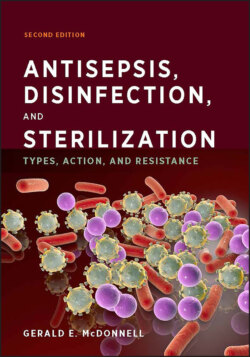Antisepsis, Disinfection, and Sterilization

Реклама. ООО «ЛитРес», ИНН: 7719571260.
Оглавление
Gerald E. McDonnell. Antisepsis, Disinfection, and Sterilization
Table of Contents
List of Tables
List of Illustrations
Guide
Pages
ANTISEPSIS, DISINFECTION, AND STERILIZATION. TYPES, ACTION, AND RESISTANCE
PREFACE
Acknowledgments
ABOUT THE AUTHOR
IMPORTANT NOTICE
1. INTRODUCTION. 1.1 GENERAL INTRODUCTION
1.2 DEFINITIONS
1.3 GENERAL MICROBIOLOGY. 1.3.1 Introduction
1.3.2 Eukaryotes and Prokaryotes
1.3.3 Eukaryotes. 1.3.3.1 MULTICELLULAR EUKARYOTES
1.3.3.2 FUNGI
1.3.3.3 ALGAE
1.3.3.4 PROTOZOA
1.3.4 Prokaryotes
1.3.4.1 EUBACTERIA
1.3.4.2 ARCHAEA
1.3.5 Viruses
1.3.6 Prions
1.3.7 Toxins
1.4 GENERAL CONSIDERATIONS. 1.4.1 Microbial Resistance
1.4.2 Evaluation of Efficacy
1.4.2.1 SUSPENSION TESTING
1.4.2.2 SURFACE TESTING
1.4.2.3 BIOLOGICAL, CHEMICAL, AND OTHER INDICATORS
1.4.2.4 PARAMETRIC CONTROL
1.4.2.5 MICROSCOPY AND OTHER TECHNIQUES
1.4.3 Disinfection versus Sterilization
1.4.4 Choosing a Process or Product
1.4.5 Guidelines and Standards
1.4.6 Formulation Effects
1.4.7 Process Effects
1.4.8 The Importance of Cleaning
1.4.9 Water Quality
FURTHER READING
2. PHYSICAL DISINFECTION. 2.1 INTRODUCTION
2.2 HEAT
2.3 COLD TEMPERATURES
2.4 RADIATION
2.5 FILTRATION
FURTHER READING
3. CHEMICAL DISINFECTION. 3.1 INTRODUCTION
3.2 ACIDS AND ACID DERIVATIVES
3.3 ALKALIS (BASES)
3.4 ALDEHYDES
3.5 ALCOHOLS
3.6 ANILIDES
3.7 ANTIMICROBIAL DYES
3.8 BIGUANIDES
3.9 DIAMIDINES
3.10 ESSENTIAL OILS AND PLANT EXTRACTS
3.11 HALOGENS AND HALOGEN-RELEASING AGENTS
3.12 METALS
3.13 PEROXYGENS AND OTHER FORMS OF OXYGEN
3.14 PHENOLICS
3.15 ANTISEPTIC PHENOLICS
3.16 QACs AND OTHER SURFACTANTS
3.17 MISCELLANEOUS BIOCIDES OR APPLICATIONS. 3.17.1 Pyrithiones
3.17.2 Biocides Integrated into Surfaces
3.17.3 Antimicrobial Enzymes, Proteins, or Peptides
FURTHER READING
4. ANTISEPTICS AND ANTISEPSIS. 4.1 INTRODUCTION
4.2 SOME DEFINITIONS SPECIFIC TO ANTISEPTICS
4.3 THE STRUCTURE OF SKIN
4.4 SKIN MICROBIOLOGY
4.5 ANTISEPTIC APPLICATIONS
4.5.1 Routine Skin Hygiene
4.5.2 Pretreatment of Skin Prior to Surgical Intervention
4.5.3 Treatment of Skin or Wound Infections
4.5.4 Treatment of Oral and Other Mucous Membranes
4.5.5 Material-Integrated Applications
4.6 BIOCIDES USED AS ANTISEPTICS. 4.6.1 General Considerations
4.6.2 Major Types of Biocides in Antiseptic Skin Washes and Rinses
4.6.3 Other Antiseptic Biocides
FURTHER READING
5. PHYSICAL STERILIZATION. 5.1 INTRODUCTION
5.2 STEAM STERILIZATION. 5.2.1 An Introduction to Steam Sterilization
5.2.2 Factors That Affect Steam Sterilization
5.3 DRY-HEAT STERILIZATION
5.4 RADIATION STERILIZATION
5.5 FILTRATION
5.6 DEVELOPING METHODS. 5.6.1 Plasma
5.6.2 Pulsed Light
5.6.3 Supercritical Fluids
5.6.4 Pulsed Electric Fields
FURTHER READING
6. CHEMICAL STERILIZATION. 6.1 INTRODUCTION
6.2 EPOXIDES
6.3 LTSF
6.4 HIGH-TEMPERATURE FORMALDEHYDE-ALCOHOL
6.5 HYDROGEN PEROXIDE
6.6 OTHER OXIDIZINGAGENT-BASED PROCESSES
6.6.1 Liquid PAA
6.6.2 Electrolyzed Water
6.6.3 Gaseous PAA
6.6.4 Ozone
6.6.5 Chlorine Dioxide
FURTHER READING
7. MECHANISMS OF ACTION. 7.1 INTRODUCTION
7.2 ANTI-INFECTIVES
7.2.1 Antibacterials (Antibiotics)
7.2.2 Antifungals
7.2.3 Antivirals
7.2.4 Antiparasitic Drugs
7.3 MACROMOLECULAR STRUCTURE
7.4 GENERAL MECHANISMS OF ACTION. 7.4.1 Introduction
7.4.2 Oxidizing Agents
7.4.3 Cross-Linking, or Coagulating, Agents
7.4.4 Transfer of Energy
7.4.5 Other Structure-Disrupting Agents
FURTHER READING
8. MECHANISMS OF MICROBIAL RESISTANCE. 8.1 INTRODUCTION
8.2 BIOCIDE-MICROORGANISM INTERACTION
8.3 INTRINSIC BACTERIAL RESISTANCE MECHANISMS
8.3.1 General Stationary-Phase Phenomena
8.3.2 Motility and Chemotaxis
8.3.3 Stress Responses
8.3.4 Efflux Mechanisms
8.3.5 Enzymatic and Chemical Protection
8.3.6 Intrinsic Resistance to Heavy Metals
8.3.7 Capsule and Slime Layer Formation and S-Layers
8.3.8 Biofilm Development
8.3.9 Bacteria with Extreme Intrinsic Resistance
8.3.10 Extremophiles
8.3.11 Dormancy
8.3.12 Revival Mechanisms
8.4 INTRINSIC RESISTANCE OF MYCOBACTERIA
8.5 INTRINSIC RESISTANCE OF OTHER GRAM-POSITIVE BACTERIA
8.6 INTRINSIC RESISTANCE OF GRAM-NEGATIVE BACTERIA
8.7 ACQUIRED BACTERIAL RESISTANCE MECHANISMS. 8.7.1 Introduction
8.7.2 Mutational Resistance
8.7.3 Plasmids and Transmissible Elements
8.8 MECHANISMS OF VIRAL RESISTANCE
8.9 MECHANISMS OF PRION RESISTANCE
8.10 MECHANISMS OF FUNGAL RESISTANCE
8.11 MECHANISMS OF RESISTANCE IN OTHER EUKARYOTIC MICROORGANISMS
FURTHER READING
INDEX
WILEY END USER LICENSE AGREEMENT
Отрывок из книги
GERALD E. McDONNELL, B.SC., PH.D.
.....
FIGURE 1.18 Typical time kill, or D-value, determination. A known concentration of the test culture is exposed to the biocide, samples are withdrawn at various times and neutralized, and the population of survivors is determined by incubation on growth medium. The actual exposure can be conducted at various temperatures, in the presence or absence of test soils, or under other test conditions.
Following exposure and neutralization of the biocide, the survivor population can be determined qualitatively or quantitatively. Quantitative methods determine the number of survivors by direct enumeration, e.g., by plating onto growth agar for bacteria and fungi (as shown in Fig. 1.18). The data from this analysis can be plotted as a time-log reduction relationship (Fig. 1.19).
.....